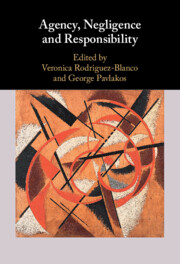Book contents
- Agency, Negligence and Responsibility
- Agency, Negligence and Responsibility
- Copyright page
- Dedication
- Contents
- Figures
- Contributors
- Acknowledgements
- Introduction
- Part I Will and Blameworthiness
- Part II Agency, Reasons and Inadvertence
- Part III The Significance of Action in Negligence
- Chapter 10 What Is It to Do Nothing?
- Chapter 11 Rape, Recklessness and Sexist Ideology
- Chapter 12 From Law to Moral Philosophy in Theorizing about Negligence
- Bibliography
- Index
Chapter 10 - What Is It to Do Nothing?
from Part III - The Significance of Action in Negligence
Published online by Cambridge University Press: 28 October 2021
- Agency, Negligence and Responsibility
- Agency, Negligence and Responsibility
- Copyright page
- Dedication
- Contents
- Figures
- Contributors
- Acknowledgements
- Introduction
- Part I Will and Blameworthiness
- Part II Agency, Reasons and Inadvertence
- Part III The Significance of Action in Negligence
- Chapter 10 What Is It to Do Nothing?
- Chapter 11 Rape, Recklessness and Sexist Ideology
- Chapter 12 From Law to Moral Philosophy in Theorizing about Negligence
- Bibliography
- Index
Summary
According to the Doctrine of Doing and Allowing, there is a moral difference between doing something and allowing it to occur. Its defenders and critics both assume the existence of an ontological difference that the purported moral difference is said to supervene upon. This difference – between so-called positive acts of doing and negative acts of not-doing – was famously introduced by Gilbert Ryle, who argued that the latter (which include neglect) were not really actions at all. He is opposed by Davidsonians who, by contrast, maintain that negative act tokens are just positive acts under negative characterisations. In this chapter, I argue that both the moral and the metaphysical debates rest on the mistaken belief that actions and/or their characterisations can be neatly divided into those that are positive and those that are negative. I use a wide range of examples to demonstrate how all action contains inaction, and vice versa. Moreover, ontological perceptions of what is positive and what is negative cannot be neatly separated from evaluative ones. None of this entails that there can never be any moral difference between doing x and allowing x to happen. But it is not one that can be captured by any principle, not least because any given instance of doing x will involve the not-doing of some other thing (a, b, or c …), and any case of of allowing x to happen will be inseparable from doing some such other thing, where the doing of a involved in allowing x may be morally worse than the allowing of a which occurs in doing x. I conclude that the Bhagavad Gita is right in proclaiming that the ability to reliably perceive one’s action in inaction, and vice versa, eludes us.
Keywords
- Type
- Chapter
- Information
- Agency, Negligence and Responsibility , pp. 187 - 204Publisher: Cambridge University PressPrint publication year: 2021

